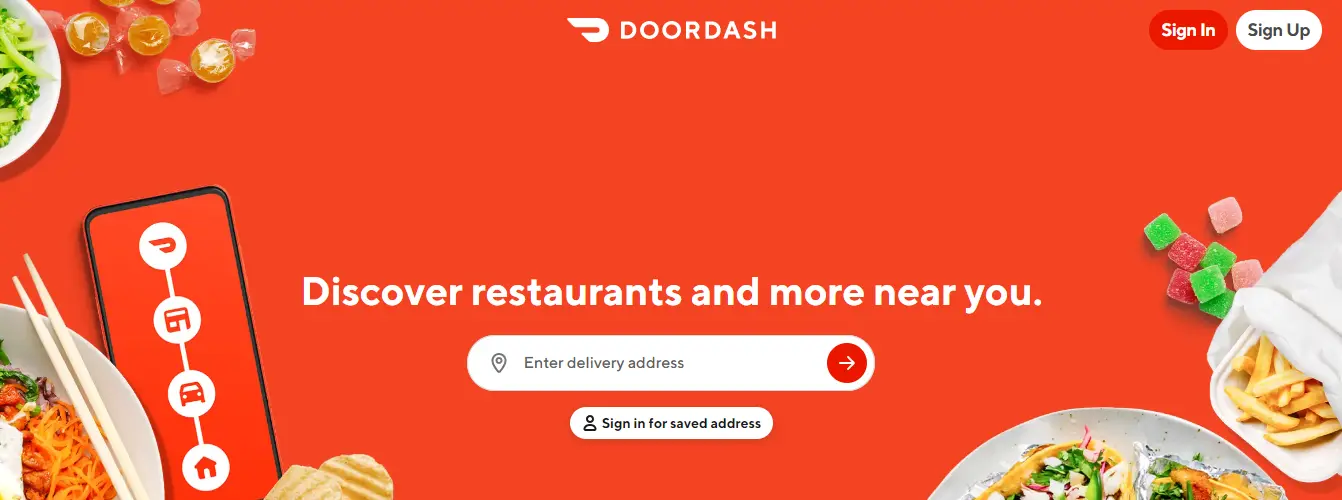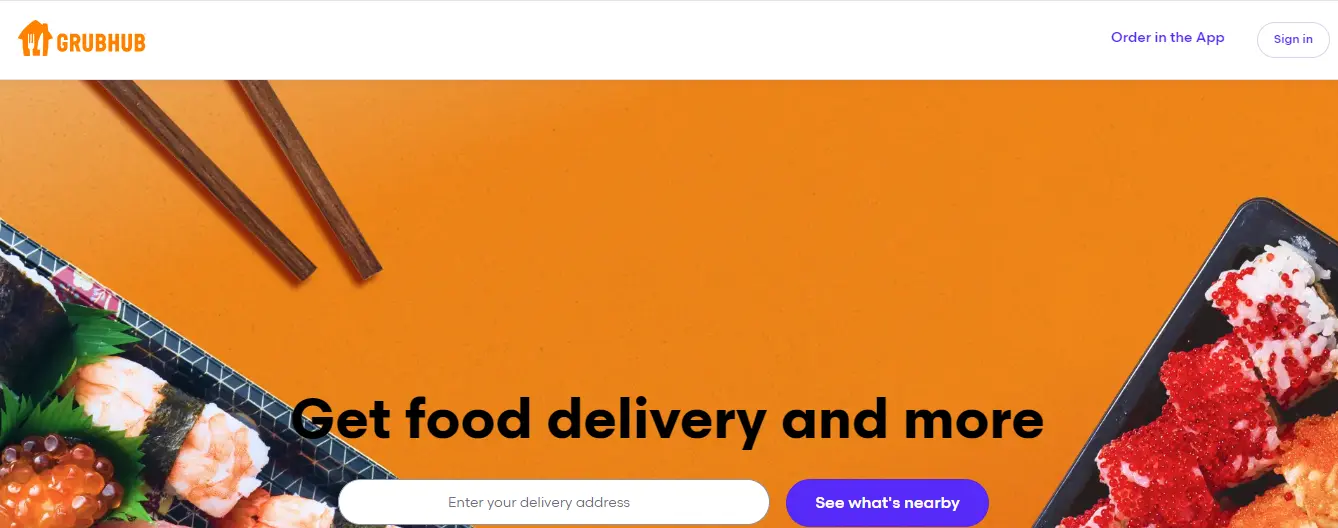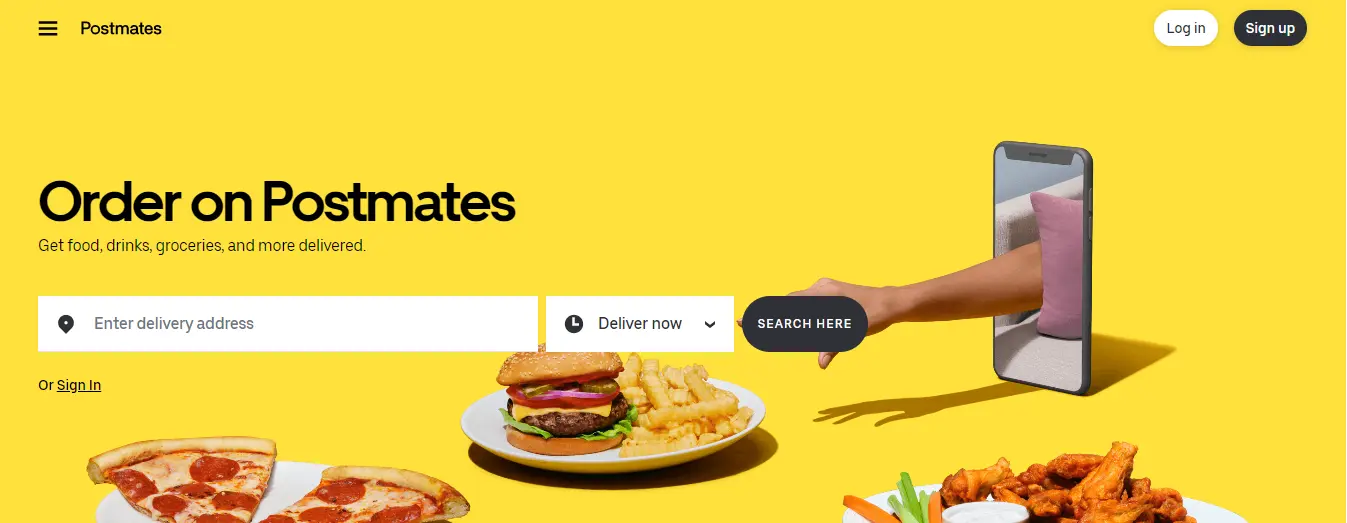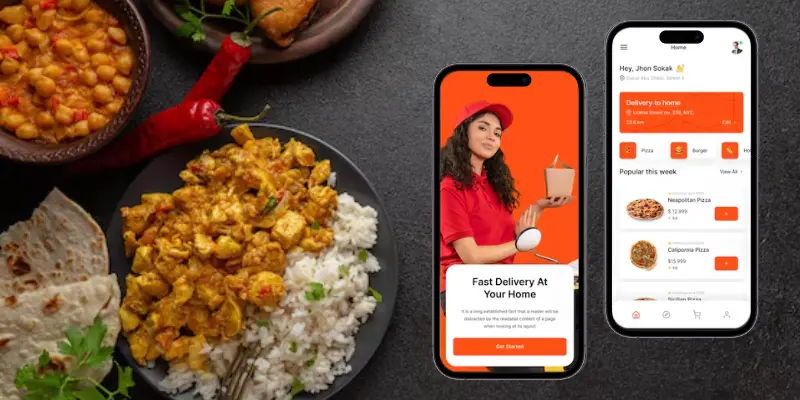Artificial Intelligence (AI) is at the essence of the industry's growth to build food delivery app. This blog will explore the incredible ways AI transforms the landscape of food delivery apps.
AI is pursuing every avenue, from personalization to efficacy to sustainability. However, it isn't easy to understand why restaurants or food service providers are searching for AI features to integrate. Do they want to stay up with the latest trends, or will AI or machine learning be the key to defining and playing a significant role in the coming years of the food industry?
The answer is straightforward. However, before we dive into the possible role of AI within the food delivery app development, let's look back and examine the fundamentals of what we are doing.
The Food Delivery App Development: Facts and Figures
-
The online food service industry is predicted to earn $269.80 billion in revenue by 2023.
-
By 2027, the global market is expected to be valued at around $473.50 billion, with an increase of 15.10 percent.
-
The restaurant industry is expected to make 29% more in 2024.
-
In 2023, the food service market will reach $182.90 billion.
-
Concerning global earnings, China is expected to bring in $395 billion in sales by 2023.
-
In 2023, a typical customer in the food and beverage business will be spending $1,36,000.
-
Foodservice is expected to be able to serve 189.40 million customers in 2027.
-
In 2023, meal service customers will comprise 48 percent of the total market.
Read Also: Food Delivery App Design: Key Features & Examples- 2024
Types of Food Delivery Apps
The market for food delivery apps is varied, providing services that meet different desires and needs. In 2024, the market will expand to include various apps catering to distinct categories of food and delivery services. From traditional delivery services to specialty offerings that have radically changed how we view food delivery. Here are the most popular kinds of apps for food delivery. Their most essential features accompany them:
Entrepreneurial-based Food Delivery Apps (e.g., DoorDash):
These apps, created by startups in the tech industry, usually offer both food and grocery delivery and provide a wide market for a variety of retailers and customers.
Food Delivery via Ride-Hailing Service Food delivery (e.g., Uber Eats):
In the beginning, they were ride-hailing companies and apps. These apps provide extensive selection options for sorting and delivery rates based on distance as well as time.
UK-based On-Demand Delivery (e.g., Deliveroo):
The initial focus is on London. These apps typically expand their offerings to include grocery delivery and agreements with local shops.
Rapid Delivery Services (e.g., Glovo):
Known for delivering anything within hours using couriers riding bicycles or motorcycles.
Delivery to Local Stores (e.g., Postmates):
Small businesses can compete with larger corporations by providing various delivery options.
Free-of-cost services (e.g., GrubHub):
It focuses on undeliverable orders and provides free delivery to subscribers.
The Niche Delivery (e.g., Caviar):
It targets a high-end market offering high-quality food and beverages from top eateries.
In-Demand Delivery of Grocery (e.g., Instacart):
It is a specialist in grocery delivery, both from national and local chains, with instant or same-day delivery.
Alcohol Delivery (e.g., Saucey):
It focuses on alcohol delivery on demand, with choices for scheduled or immediate delivery.
Varying Services (e.g., TaskRabbit):
It offers various services, such as breakfast and grocery delivery, with taskers setting the prices.
Each kind of food delivery app development addresses distinct consumer needs, demonstrating the changing characteristics of consumer preferences in the digital age.
Read Also: Food Delivery Apps: What Trends and Features are Used in 2024
Steps to Develop a Food Delivery App
Food delivery app development company like Make IT Simple use a tested and proven development method to ensure that their apps are competitive in the marketplace.
Here's what you can do.
Identify Your Target Market
Finding your ideal market is a vital initial step for food delivery app development. The process includes:
-
Demographic Analysis: Find your prospective users' income, age, food habits, and lifestyle.
-
Geographical Focus: Select the geographic areas where your app will first be operational.
-
Cultural Preferences: Learn about the preferences of local cuisines and restrictions on dietary choices.
This helps you tailor your app to meet your targeted audience's particular requirements and preferences. For example, if you are targeting people who work and live in urban regions, your app could focus on quick delivery options from a variety of eateries.
Consider UberEats, for instance. Their success is largely due to their deep comprehension of their customer base.
They recognized the need for speedy and reliable food delivery to professionals and urban dwellers and professionals, which led to the development of a model of service specifically designed to meet these groups' needs.
Conduct Market Research
Market research is crucial to know the competitive landscape as well as user expectations. It involves:
-
Analyzing Competitors: Examine existing apps for food delivery to determine what is working and any potential flaws.
-
User Expectations: Collect information on the services and features customers are most interested in.
-
Trend Analysis: Stay on top of new trends that are emerging in the delivery of food.
DoorDash's entry into the market was based on thorough research, a deep understanding of local preferences, and a recognition of the gaps that competitors had left.
The research approach enabled them to provide services immediately appealing to their intended audience.
Choose a Business Model
Choosing the best business model is crucial to the app's monetization strategy. There are a variety of options to choose from:
-
Commission-based model: The charging restaurants a percentage of each order.
-
The subscription model: It provides premium features in exchange for a monthly subscription.
-
Advertising Model: Creating income through ads in-app.
Grubhub's commission-based business model proves their understanding of the revenue-generating path.
Their business model balances profitability and appealingness to restaurants that partner with them to create a sustainable model for business.
Define Key Features and Functionalities
A food delivery app development success greatly depends on its features and functions. The most important features are:
-
User-Friendly Interface: A simple-to-use, user-friendly design for the app.
-
The Order Tracking System: Live information on the status of orders.
-
Multiple Payment Options: Including e-wallets, credit/debit cards, etc.
Domino's Pizza's app, specifically the real-time tracker feature, illustrates how understanding customer preferences can lead to developing features that significantly improve the user experience and satisfaction.
Design the User Interface and Experience
The application design should focus on providing a great user experience. This means:
-
Simple and straightforward: A simple and clear design that is simple to navigate.
-
Attractive visual design: Utilize attractive layouts and visuals.
-
Responsive Design: Assure the app is optimized for screens and devices of different sizes.
Zomato's user interface is centered around the user experience and appealing visuals, which has been an important factor in its widespread adoption.
Their user-friendly interface makes it simple for customers to search for and purchase their most loved dishes, highlighting the importance of food.
Find a Reliable App Development Company
Selecting the best development partner is essential for food delivery application development. Things to consider are:
-
Experience and expertise: Look for a firm with a solid portfolio of app development, particularly in food delivery.
-
Technical Proficiency: Ensure they are proficient in current technology and the latest trends.
-
Customer Testimonials: Review reviews from past clients to assess their trustworthiness and the quality of service.
When McDonald's teamed up with Capgemini to create the McDelivery application, it not only increased their digital presence but also significantly increased online sales.
This collaboration was crucial in integrating new features that suited McDonald's specific needs for service.
A reputable food delivery app development company will make an enormous difference in the success of your food delivery application. Call Get IT Simple today, and we'll explain how we can help you win the marketplace!
Develop a Minimum Viable Product (MVP)
An MVP lets users test the application's main functions using real users before the full-scale development. It should contain:
-
Essential Features: Only integrate the essential functions first.
-
The User Feedback Mechanism: Develop an avenue to collect feedback from users.
-
Potential for Scalability: Ensure the MVP can be scaled in response to feedback.
Postmates began with a basic version focused on the core functions that enabled them to evaluate the market and improve their offerings.
This helped them better discover their users' preferences and grow their app in the later stages.
Testing of apps is vital to ensure usability, functionality, and security. This includes:
-
Functional Test: to verify whether all features function in the way they were intended.
-
Test User Experience: To confirm that the app is intuitive and user-friendly.
-
Security tests: These are used to protect transaction data and users' personal information.
Deliveroo's method of app updates and testing is a reflection of their commitment to high quality.
Every feature is thoroughly tested to ensure that any new enhancements improve user experience without compromising safety or performance.
Launch the App in a Target Market
The process to build food delivery app in a specific market will require:
-
Strategic Release: Picking the ideal time and place for your event.
-
Initial Promotion: Market the app to increase awareness.
-
Monitoring and support: Be ready to respond promptly to any issue.
DoorDash's market launch strategy started with specific cities, which allowed them to comprehend the diverse needs of markets and adjust accordingly.
This targeted launch has helped them establish a solid local presence before expanding into new regions.
Gather User Feedback and Iterate
After launch, it's crucial to
-
Take feedback: Feedback via reviews, surveys, or app analytics.
-
Iterative Improvement: Regularly upgrade the app based on feedback.
-
Continuous Development: Keep improving the app to provide a better user experience.
Uber Eats' model of including customer feedback in its food delivery app development process has been key to its ability to adapt and succeed.
They constantly use customer feedback to create features that improve customer satisfaction and engagement.
Read Also: The Future of Food Delivery Sector in 2024-2025
Implement Marketing and Promotional Strategies
Effective marketing is the key to the app's successful launch. This includes:
-
Digital Marketing: Utilizing SEO, social media, and online advertisements.
-
Collaborations and Partnerships: Aligning with influencers and restaurants.
-
Special Discounts and Offers: Special discounts and offers help entice and retain customers.
Zomato's marketing strategy, which incorporates outreach via social media and partnerships, has played a key role in its growth. The company's ability to engage with users by sharing relatable content and collaborating with restaurants has dramatically enhanced its exposure and base.
Plan for Ongoing Support and Maintenance
Maintaining the app post-launch is as essential as ensuring you have adequately developed it. This means:
-
Regular Updates: Keep the app up-to-date with security and features.
-
Customer Support: Provides rapid and efficient support for users.
-
The Performance Monitor: Always monitor the app's performance in case of problems.
Instacart's commitment to maintaining its app and customer support is apparent through its regular updates. These updates fix technical issues and introduce new features that enhance customers' shopping experiences.
Food Delivery Apps Using AI-Powered Technology in 2024
In the field of delivery services, technological advances continue to revolutionize how we purchase and receive our most-loved meals. In 2024, apps will use AI-powered solutions more than ever before to improve customer experiences and efficiency.
From personalized suggestions to more efficient logistics for delivery, Here are five food delivery app development at the forefront of this revolution.
Uber Eats

Uber Eats is a well-known food delivery service that uses AI-powered technology to optimize delivery routes and predict delivery times precisely. It also uses machine-learning algorithms to study customers' preferences and recommend personalized food choices. In addition, in the past year, Uber Eats revealed plans to roll out an AI-powered assistant that will aid users in finding bargains and discovering different food options. The AI chatbot can respond to users' questions, provide recommendations, and help customers reorder their past meals.
DoorDash

DoorDash is a delivery application that uses AI technology to enhance the effectiveness of its delivery services. The app uses predictive analytics to predict high-demand times for food delivery application development and then assign resources accordingly, ensuring punctual delivery to customers. DoorDash recently introduced the AI-powered voice order service, which allows restaurants to boost their revenue by responding to all the calls they receive. It will also give customers personalized recommendations that complement their food. Another brand new feature, SafeChat+, uses AI to analyze conversations in the app to identify and stop the harassment or abuse of a person, which is a frequent security issue.
Grubhub

Grubhub is a food delivery app development that uses AI-powered technology to enhance user experience. The app uses natural language processing to recognize customer preferences and give them personalized recommendations for dining out and food. The app recently added the Amazon Walk Out Technology to affiliated campuses across the U.S., enabling students to walk into a shop using a QR code inside the Grubhub application, and the technology detects what customers choose to buy or return to the shelves. Once students are done shopping, they'll be permitted to leave the shop, and the purchase will be taken out of the meal plans, decreasing the balance on their account or any other payment options linked with their Grubhub account.
Instacart

Instacart is a delivery service for groceries application that uses AI-powered technology to offer customers an effortless shopping experience. The app uses computer vision technology to determine and categorize groceries to ensure precise and efficient delivery. In addition, Instacart recently unveiled several improvements on their AI-powered Caper Carts, which are currently being used by retailers at stores all over the U.S. This includes enhancements to the speed and accuracy of the sensors for weight and camera in the most recent version of Caper Carts as well as the capability to purchase made-to-order items such as deli sandwiches straight from intelligent carts. Customers can place orders when browsing through the aisles and do not need to travel to the counter at the deli or bakery or stand in a line.
Postmates

Postmates is a delivery service that uses AI technology to build food delivery app processes. Postmates uses machine learning algorithms to enhance delivery routes and reduce delivery time. Additionally, Serve Robotics, a spin-off of Postmates that Uber bought, recently secured $30 million in funding for its AI-powered automated delivery system. The company's total budget will be $56 million by 2021, enabling it to expand its fleet of robots to meet customers' ever-growing demand for automated delivery.
Essential Food Delivery App Features
Food delivery app development is more user-friendly and advanced than ever. To meet the ever-changing requirements of administrators, customers, and employees, the apps must incorporate various essential features that improve the efficiency, user-friendliness, and quality of service. Five vital functions in each of the categories:
For Users
Real-Time Order:
Tracking enables customers to track their orders in real-time, increasing transparency and satisfaction of customers.
Different Payment Methods:
It accepts different payment options, such as credit/debit cards, e-wallets, and cash-on-delivery, which provides convenience.
Advanced Search and Filters:
It enables users to find restaurants, cuisines, or particular dishes, enhancing their experience.
Rates and reviews:
This feature allows users to review and rate dishes and restaurants, assisting others in making educated decisions.
Customizable orders:
These allow you to make changes to your orders, like adding additional toppings or diet preferences, and cater to your individual preferences.
For Administrators
Dashboard to Manage Order Management:
The dashboard is a tool for tracking and managing orders effectively.
Analysis and reporting tools:
This section offers information on customer behaviour, sales, and the most popular products that aid in making informed decisions.
Invoice Management:
Aids monitor and manage inventory levels to ensure smooth delivery of orders.
The Restaurant Management and On-boarding process:
Allows the creation and management of menus and restaurants on the platform.
Contact Support:
A unified system that efficiently handles customer questions and complaints.
For Staff
The Order Dispatch System:
It effectively assigns orders to delivery staff depending on location and availability.
GPS Route and Navigation Aids:
Food delivery application development personnel find the most efficient and fastest routes to their destinations.
In-App Communication:
Allows personnel to communicate with administrators or customers during delays or problems.
Monitoring Delivery Performance:
Tracks the delivery time and customer feedback and assesses performance.
Processing of Tips and Payments:
Processes tips and payments received and ensures an accurate and complete accounting.
Benefits Of Developing A Food Delivery App
The evolving food delivery app development allows businesses to grow and increase profits. Businesses can prosper in a digital world by focusing on efficiency, streamlining operations, and using data-driven information.
Market Demand
In the past, we have examined the market for food delivery in detail, highlighting the issues facing restaurants and stores that are unable to adjust. It's clear that people today expect food delivered right to their doorsteps, which mirrors the change in the retail industry during Amazon's expansion.
The expectation is even extended to food delivery services. Failure to provide mobile delivery could result in customers being lost to rivals that provide it. Beyond the numbers, the societal shift towards convenience emphasizes the importance of changing to meet customers' needs.
Time-Saving Benefits for Customers
Ordering takeaway can be very time-consuming, particularly in busy cities where parking is limited. Because of traffic and parking problems, a quick trip can take half an hour in major cities such as New York, Los Angeles, and Boston. Many people find that this kind of time expenditure isn't worth it.
A recent survey showed that 77% of customers are willing to pay a little extra to speed up food delivery. Beyond the mere time for delivery, Delivery services remove the necessity to stand in lines or juggle busy restaurants, substantially improving convenience.
User-Friendly Ordering Process
The food delivery application development can provide convenience for consumers and businesses. You'll no longer have to wait for a call, try to make contact over a noisy background, or try to understand accents.
It's as easy as choosing items from an online or grocery list menu, placing them in the cart, and then paying upfront. This process is efficient for both the business, which receives instant payment, and the customers, who have a seamless experience.
Additionally, the simple design of the platforms allows for accessibility to all ages without requiring prior knowledge.
Improved Return on Investment
These apps can rapidly return on their initial investment in food delivery app development. Monthly subscription fees for app creators generally range between $300 and $1,000, which provides clearly defined break-even points for businesses.
In addition, the capacity of these applications allows companies to adapt to changing demand and optimize resources for the greatest profit. Data-driven insight can help improve the decision-making process, allowing businesses to develop strategies and maintain an edge in the market.
Business Expansion Opportunities
Build food delivery app that provides new revenue streams to companies, which is crucial in today's ever-changing market. Delivery services are becoming commonplace, so adapting is essential to remaining current with customers.
Furthermore, including delivery services improves business value propositions while attracting and keeping customers looking for convenience. By leveraging the existing network and branding name recognition, companies can expand into new markets and reach out to previously untapped consumer segments.
Conclusion
Undoubtedly, AI for the food service sector has changed how food companies operate. Whatever your app concepts or features, like machine learning for food delivery, you must find and employ a food delivery app development company who can build the best possible software.
To make it more efficient and profitable, look for niche-experienced professionals who have previously completed similar tasks (including white-label application development) that are in your interests.
Thus, the app developers hired cannot only develop a top-quality application but also provide guidance throughout the outsourced software development cycle, assist you in choosing the appropriate technology stack, and impart knowledge to your internal team, should they have any.





.webp)







Share this blog